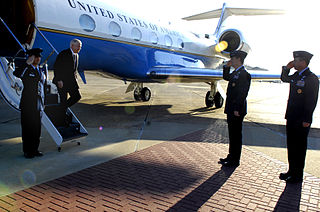
The 42nd Air Base Wing is a United States Air Force unit assigned to Air University of Air Education and Training Command. It is stationed at Maxwell-Gunter Air Force Base, Alabama and is the host unit for Maxwell-Gunter. The wing's primary mission is to support all activities of Air University, the 908th Airlift Wing and other tenant units stationed at Maxwell-Gunter.

The 494th Air Expeditionary Group is a provisional United States Air Force group assigned to Air Mobility Command (AMC) to activate or inactivate as needed. The group was activated in the events surrounding Operation Iraqi Freedom, the 2003 United States invasion of Iraq. Now-Lieutenant General Stayce D. Harris is listed by the USAF as commanding the 494th AEG at Moron Air Base, Spain, from July to October 2003. In addition, a patch published at USAF Patches.com implies that the group was active in Spain during "Iraqi Freedom."

The 32nd Air Refueling Squadron is part of the 305th Air Mobility Wing at Joint Base McGuire-Dix-Lakehurst, New Jersey. It operates the Boeing KC-46A Pegasus aircraft conducting air refueling missions. The squadron is one of the oldest in the United States Air Force, its origins dating to 19 May 1917, being organized at Camp Kelly, Texas. The squadron deployed to England as part of the American Expeditionary Force during World War I. During World War II, the squadron saw combat service as a Boeing B-17 Flying Fortress unit, assigned to the Fifteenth Air Force in Italy. During the early years of the Cold War, it was a Boeing RB-47 Stratojet strategic reconnaissance squadron as part of Strategic Air Command.

The 92nd Air Refueling Squadron, officially 92d Air Refueling Squadron, is a squadron of the 92nd Air Refueling Wing's 92nd Operations Group, stationed at Fairchild Air Force Base, Washington. It was first activated shortly before the entry of the United States into World War II as the 2nd Reconnaissance Squadron. After training in the Douglas B-18 Bolo in the southeastern United States, the squadron moved to the Pacific Coast after the Japanese attack on Pearl Harbor and participated in antisubmarine patrols with the Consolidated B-24 Liberator. In April 1942, it was redesignated the 392nd Bombardment Squadron. Starting in mid-1942, it also began training crews on the Liberator. It ended these operations in July 1943 and began to prepare for overseas movement. After three months of training, the squadron moved to the Central Pacific, where it flew its first combat mission in November. The 392nd continued combat operations until March 1945, when it was withdrawn and moved to Hawaii, where it conducted routine training and patrol operations until it was inactivated in November 1945.

The 427th Reconnaissance Squadron is an active United States Air Force (USAF) unit assigned to Beale Air Force Base, California.
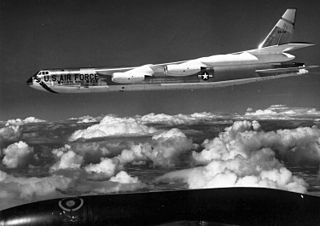
The 864th Bombardment Squadron is an inactive United States Air Force unit. Its last assignment was with the 494th Bombardment Wing at Sheppard Air Force Base, Texas, where it flew Boeing B-52 Stratofortresses under Strategic Air Command. It was inactivated on 2 April 1966.

The 865th Technical Training Squadron is an inactive United States Air Force unit. Its last assignment was with the 1st Missile Division at Redstone Arsenal. Alabama, where it trained Italian Air Force personnel on the SM-78 Jupiter. It was inactivated on 1 November 1959.

The 866th Bombardment Squadron is an inactive United States Air Force unit. Its last assignment was as the 866th Technical Training Squadron with the 1st Missile Division at Redstone Arsenal, Alabama, where it trained for overseas deployment the SM-78 Jupiter. It was inactivated on 25 May 1962.

The 45th Operations Group was a United States Space Force unit. It was assigned to 45th Space Wing, stationed at Cape Canaveral Space Force Station, Florida. In May 2021, it was inactivated upon the redesignation of the 45th Space Wing to Space Launch Delta 45.
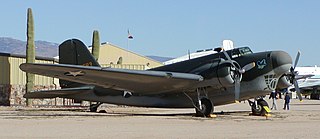
The 417th Bombardment Squadron was a United States Army Air Forces unit. It was activated in the fall of 1939 as the 27th Reconnaissance Squadron and moved to Puerto Rico two months later. Following the attack on Pearl Harbor it engaged in antisubmarine patrols in the Caribbean until the antisubmarine mission was taken over by the Navy. In the spring of 1944, it returned to the United States, where it was disbanded on 20 June 1944.

The 44th Reconnaissance Squadron is a unit of the United States Air Force's 432nd Wing, Air Combat Command stationed at Creech Air Force Base, Nevada, where it operates unmanned aerial vehicles. The squadron is assigned to the 432nd Operations Group, and has been reported to operate the Lockheed Martin RQ-170 Sentinel.
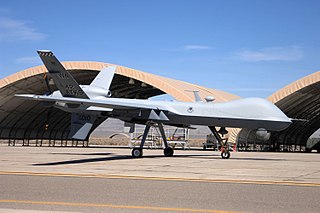
The 22nd Attack Squadron is a United States Air Force unit assigned to the 432d Wing Air Combat Command at Creech Air Force Base near Indian Springs, Nevada. It flies General Atomics MQ-9 Reaper Unmanned aerial vehicles.
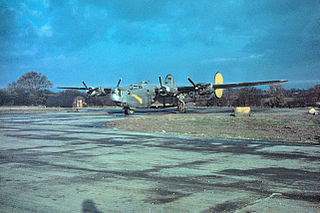
The 847th Bombardment Squadron is a former United States Army Air Forces unit that was originally activated as the 421st Bombardment Squadron. Its last assignment was with the 489th Bombardment Group at Great Bend Army Air Field, Kansas where it was inactivated on 28 March 1945. As the 20th Antisubmarine Squadron, the squadron performed antisubmarine patrols in 1942 and 1943. After reforming as a heavy bomber squadron, it engaged in the strategic bombing campaign against Germany in the European Theater of Operations until returning to the United States in late 1944. The squadron was inactivated while its parent group was training as a very heavy bombardment unit.
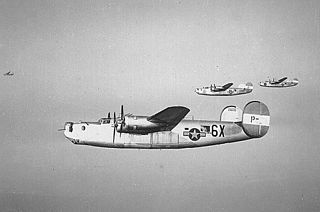
The 855th Bombardment Squadron is an inactive United States Air Force unit. The squadron was first activated as the 522d Bombardment Squadron at Lantana Airport, Florida, in October 1942, when it assumed the personnel and equipment of a National Guard unit engaged in antisubmarine warfare over the Atlantic. The squadron continued antisubmarine patrols as the 17th Antisubmarine Squadron until the summer of 1943, when its mission was transferred to the Navy.

The 859th Special Operations Squadron is a reserve unit of the United States Air Force. It was first activated in October 1942 as the 517th Bombardment Squadron, when the Army Air Forces replaced National Guard observation units that had been mobilized and were performing antisubmarine patrols off the Atlantic coastline. A month after its activation, the squadron was redesignated the 12th Antisubmarine Squadron. In August 1943, the Army Air forces began turning the antisubmarine patrol mission over to the Navy and the squadron moved to California, where, as the 859th Bombardment Squadron, it formed the cadre for the 492d Bombardment Group.

The 835th Bombardment Squadron is an inactive United States Army Air Forces unit. It was activated in January 1941 as the 80th Bombardment Squadron and equipped with Douglas A-20 Havoc light bombers. Following the attack on Pearl Harbor the squadron began to fly antisubmarine patrols off the Atlantic coast and over the Caribbean Sea, becoming the 9th Antisubmarine Squadron.

The 325th Weapons Squadron is a United States Air Force unit assigned to the USAF Weapons School, stationed at Whiteman Air Force Base, Missouri, it is a geographically separated unit of the 57th Wing at Nellis Air Force Base, Nevada. The mission of the squadron is to provide Northrop Grumman B-2 Spirit instructional flying.

The 394th Combat Training Squadron was a United States Air Force unit assigned to the 509th Operations Group until inactivated on 13 April 2018. It was stationed at Whiteman Air Force Base, Missouri. The mission of the squadron was to train Northrop Grumman B-2 Spirit aircrews, a mission now executed by the 13th Bomb Squadron. The 394th is the fourth oldest squadron in the United States Air Force. Its history dated to 5 May 1917 as the 4th Aero Squadron.

The 839th Bombardment Squadron is an inactive United States Army Air Forces unit. It was activated in January 1941 as the 79th Bombardment Squadron and equipped with Douglas A-20 Havoc light bombers. Following the attack on Pearl Harbor the squadron began to fly antisubmarine patrols off the Atlantic coast and over the Caribbean Sea, becoming the 8th Antisubmarine Squadron.

The 6th Air Defense Missile Squadron was an air defense unit of the United States Air Force. It was assigned to the New York Air Defense Sector of Aerospace Defense Command, at Suffolk County Air Force Base, New York, where it was inactivated on 15 December 1964. The squadron had its headquarters at Suffolk County Air Force Base, while the firing batteries of the squadron were at the nearby Suffolk County Air Force Base Missile Annex.




























